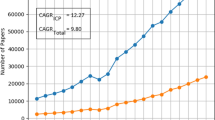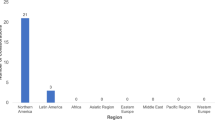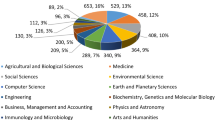Abstract
The study of international collaborations can help in understanding the benefits of such relationships and aid in developing national financing policies. In this paper, the international collaboration of Brazilian scientists was studied using SciVal® and Incites® database, looking at its effect on the universities, financing agencies and different areas of knowledge and research topic clusters. Cluster and principal component analyses of scientometric data were carried out. While the results confirmed known knowledge that international collaboration increases impact, this study shows that Brazilian researchers are contributing to prominent research topics worldwide, in all areas of knowledge. This finding is contrary to several points of view that identify Brazil as a regional and not an international partner in science. Important also to note the impact of Brazilian authors in international collaboration that is well above the world mean. The collaboration of Brazil with foreign partners brings benefits for both sides, creating the opportunity of Brazilian research access to financing from international agencies. Increases in measures of impact are also seen for both sides. Foreign partners likewise benefit from higher impact factors in the same topic cluster, when collaborating with Brazilian partners. Publishing open access in high impact journals is fundamental for maintaining Brazilian science at the forefront.










Similar content being viewed by others
References
Adams, J. (2013). The fourth age of research. Nature, 497, 557–560. https://doi.org/10.1038/497557a.
Adams, J. (2012). Collaborations: The rise of research networks. Nature, 490, 335–336.
Arruda, R. 2017. Brazil’s newest attempt at internationalization. Inside higher Ed. https://www.insidehighered.com/blogs/world-view/brazil%E2%80%99s-newest-attempt-internationalization
Atallah, Á. N., & Puga, M. E. S. (2007). CAPES publications portal: a decisive milepost in Brazilian scientific development providing sources of evidence for researchers, students and health professionals. Sao Paulo medical journal, 125, 203–204. https://doi.org/10.1590/S1516-31802007000400001.
Barjak, F., Eccles, K., Meyer, E. T., Robinson, S., & Schroeder, R. (2013). The emerging governance of e-infrastructure. Journal of Computer-Mediated Communication. https://doi.org/10.1111/jcc4.12000.
Boekholt, P., Edler, J., Cunningham, P.C., & Flanagan, K. (2009). Drivers of international collaboration in research. Study for the European commission, DG research, Amsterdam, Brussels, Manchester: European commission. https://www.eurosfaire.prd.fr/7pc/doc/1266832886_drivers_of_international_cooperation_in_research.pdf
Bozeman, B., Fay, D., & Slade, C. P. (2013). Research collaboration in universities and academic entrepreneurship: The-state-of-the-art. J. Technol. Transf., 38, 1–67. https://doi.org/10.1007/s10961-012-9281-8.
Bulaitis, Z. (2017). Measuring impact in the humanities: Learning from accountability and economics in a contemporary history of cultural value. Palgrave Communications. https://doi.org/10.1057/s41599-017-0002-7.
Catalá-López, F., Alonso-Arroyo, A., Hutton, B., Aleixandre-Benavent, R., & Moher, D. (2014). Global collaborative networks on meta-analyses of randomized trials published in high impact factor medical journals: a social network analysis. BMC Med, 12, 15. https://doi.org/10.1186/1741-7015-12-15.
Chinchilla-Rodríguez, Z., Vargas-Quesada, B., Hassan-Montero, Y., González-Molina, A., & Moya-Anegón, F. (2010). Information Visualization, 9, 277–287. https://doi.org/10.1057/ivs.2009.31.
Choi, S. (2012). Core-periphery, new clusters, or rising stars? international scientific collaboration among ‘advanced’ countries in the era of globalization. Scientometrics, 90(1), 25–41. https://doi.org/10.1007/s11192-011-0509-4.
Cummings, J. N., & Kiesler, S. (2007). Coordination costs and project outcomes in multi-university collaborations. Research Policy, 36(10), 1620–1634.
de Sandes-Guimaraes, L. V., Ribeiro, A. T. V. B., Axel-Berg, J. H., de Rosso Manços, G., & Plonski, G. A. (2020). The impact of international student mobility programs on Brazilian students’ perceptions of entrepreneurialism. Journal of Studies in International Education, 24(2), 249–268. https://doi.org/10.1177/1028315319842345.
Dorigon, T. (2016). O Programa Idiomas sem Fronteiras Analisado a partir do Ciclo de Políticas. BELT-Brazilian English Language Teaching Journal. https://doi.org/10.15448/2178-3640.2015.s.21009.
Fest, E., Jetten, T., Derkx, R., Togt, P., Post, M., Veller, M., et al. (2017). Bibliometric analysis at Wageningen university and research–comparison of three bibliometric systems. Figshare Poster. https://doi.org/10.6084/m9.figshare.5621116.v1.
Gray, A, Price, R. 2020. Using InCites responsibly: A guide to interpretation and good practice. https://spiral.imperial.ac.uk:8443/handle/10044/1/75946
Grochocki, L. F. M., & Guimarães, J. A. (2017). A contribuição do programa capes/brafitec para a internacionalização dos cursos de graduação em engenharia no brasil. Revista de ensino de engenharia., 36, 72–84. https://doi.org/10.5935/2236-0158.20170007.
Haddow, G., & Genoni, P. (2010). Citation analysis and peer ranking of Australian Social Science journals. Scientometrics, 85, 471–487.
Haddow, G., Xia, J(C), Willson, M. 2017. Collaboration in HASS in Australia. Australian Universities´ Review 59:24–36
Hinds, P., & Bailey, D. E. (2003). Out of sight, out of sync: understanding conflict in distributed teams. Organisation Science, 16(6), 615–632.
Hoekman, J., Frenken, K., & Tijssen, J. W. (2010). Research collaboration at a distance: Changing spatial patterns of scientific collaboration within Europe. Research Policy, 39, 662–673. https://doi.org/10.1016/j.respol.2010.01.012.
Hossain, M.M. 2020Current status of global research on novel coronavirus disease (COVID-19): A bibliometric analysis and knowledge mapping. Available at SSRN: https://ssrn.com/abstract=3547824 or http://dx.doi.org/https://doi.org/10.2139/ssrn.3547824
Huang, M. H., & Lin, C. S. (2010). International collaboration and counting inflation in the assessment of national research productivity. Proceedings of the American Society for Information Science and Technology, 47(1), 1–4.
Jeong, S., Choi, J. Y., & Kim, J.-Y. (2014). On the drivers of international collaboration: The impact of informal communication, motivation, and research resources. Science and Public Policy, 41, 520–531. https://doi.org/10.1093/scipol/sct079.
Kulkarni, A. V., Aziz, B., Shams, I., & Busse, J. W. (2009). Comparisons of citations in web of science, scopus, and google scholar for articles published in general medical journals. Journal of the American Medical Association, 302, 1092–1096.
Leta, J. (2011). Growth of Brazilian science: A real internalization or a matter of databases´ coverage? In: E. Noyons, P. Ngulube, J. Leta (Eds), Proceedings of ISSI 2011–The 13th International Conference on Scientometrics and Informetrics, Durban, South Africa, Vol. 1, 392–397.
Leta, J., & Chaimovich, H. (2002). Recognition and international collaboration: The Brazilian case. Scientometrics, 53, 325–335.
Leta, J., Thijs, B., & Glänzel, W. (2013). A macro-level study of science in Brazil: seven years later. Encontros Bibli: revista eletrônica de biblioteconomia e ciência da informação, 18, 51–66.
Leydesdorff, L., Wagner, C., Park, H.W., Adams, J. 2013. International Collaboration in Science: The Global Map and the Network. arXiv. 10.3145/epi.2013.ene.12
Martinez, M., & Sá, C. (2020). Highly cited in the south: International collaboration and research recognition among Brazil’s highly cited researchers. J of Studies in International Education. https://doi.org/10.1177/1028315319888890.
McManus, C., & Nobre, C. A. (2017). Brazilian scientific mobility program-science without borders-preliminary results and perspectives. Anais da Academia Brasileira de Ciências. https://doi.org/10.1590/0001-3765201720160829.
McManus, C., & Baeta Neves, A. A. (2020). Production Profiles in Brazilian Science, with special attention to Social Sciences and Humanities. Scientometrics. https://doi.org/10.1007/s11192-020-03452-2.
McManus, C., Baeta Neves, A. A., Diniz Filho, J. A., Maranhão, A. Q., & Souza Filho, A. G. (In press). Profiles not metrics: The case of Brazilian universities. Anais da Academia Brasileira de Ciências.
McManus, C., Baeta Neves, A. A., & Maranhão, A. Q. (2020). Brazilian publication profiles: Where and how Brazilian authors publish. Anais da Academia Brasileira de Ciências., 92(2), e20200328. https://doi.org/10.1590/0001-3765202020200328.
Mongeon, P., & Paul-Hus, A. (2016). The journal coverage of web of science and scopus: A comparative analysis. Scientometrics, 106, 213–228.
Mugnaini, R., DiGiampietri, L. A., & Mena-Chalco, J. P. (2014). Scientific communication in Brazil (1998–2012): Indexing, growth, flow and dispersion. Transinformação, 26(3), 239–252.
Nunes, B. F. (2006). The science and technology system in Brazil and international cooperation: notes about the Capes/Cofecub experience/O sistema de C&T no Brasil e a cooperacao internacional: notas sobre a experiencia Capes/Cofecub. Revista Brasileira de Pos-Graduacao, 3, 234–253.
Schuch, R., & Hellingrath, B. (2014). Bridging Europe and Latin America - The Brazil centre of the university of Münster (pp. 77–88). Germany, In: European Higher Education Institutions' Collaboration With Latin America.
Springer, Everett P., & Milligan, Shelby. Analysis of Publication Trends for DOE National Laboratories Comparisons using WoS and Scopus. United States. doi:https://doi.org/10.2172/1374264.
Teixeira da Silva, J. A. (2011). The ethics of collaborative authorship More realistic standards and better accountability are needed to enhance scientific publication and give credit where it is due. EMBO Reports, 12(9), 889–893. https://doi.org/10.1038/embor.2011.161.
Torres-Salinas, D., Lopez-Cózar, E. D., & Jiménez-Contreras, E. (2009). Ranking of departments and researchers within a university using two different databases: Web of Science versus Scopus. Scientometrics, 80, 761–774.
Wagner, C. S., Whetsell, T. A., & Leydesdorff, L. (2017). Growth of international collaboration in science: Revisiting six specialties. Scientometrics, 110, 1633–1652. https://doi.org/10.1007/s11192-016-2230-9.
Waltman, L. (2016). A review of the literature on citation impact indicators. Journal of Informetrics, 10, 365–391.
Westphal, A. S. (2013). The internationalization process of graduate studies in Brazil. Cultural and Pedagogical Inquiry, 2013(5), 4–13.
Zeng, S.-J., Ma, G., Dobránszki, J., Bulley, S., Winarto, B., Van, P. T., et al. (2011). Ethical international scientific writing collaboration, co-operation and partnerships around the world. Case studies and testimonials. Scientific Research and Essays, 6(33), 6730–6747.
Acknowledgements
To CAPES and CNPq for financing. AGSF acknowledges the funding from Fundação Cearense de Apoio ao Desenvolvimento Científico e Tecnológico (FUNCAP) through the Cientista Chefe program.
Author information
Authors and Affiliations
Corresponding author
Electronic supplementary material
Below is the link to the electronic supplementary material.
Appendices
Abbreviations
- Cit/Doc:
-
Number of citations per document
- CNCI:
-
Category Normalized Citation Impact of a document is calculated by dividing the actual count of citing items by the expected citation rate for documents with the same document type, year of publication and subject area. This is used in InCites® and based on the Web of Science
- CS:
-
CiteScore of an academic journal is a measure reflecting the yearly average number of citations to recent articles published in that journal
- DOAJ:
-
Directory of Open Access Journals is a community-curated online directory that indexes and provides access to high quality, open access, peer-reviewed journals
- DocCit:
-
Number of documents in the database in the period studied that had at least one citation in the database
- FWCI:
-
Field Weighted Citation Index - is the ratio of the total citations actually received by the denominator’s output, and the total citations that would be expected based on the average of the subject field. Similar to CNCI, this is from SciVal® based on data from Scopus
- High:
-
Highly cited papers are papers that perform in the top 1% based on the number of citations received when compared to other papers published in the same field in the same year
- Hot:
-
Hot papers - are papers published in the last two years that are receiving citations quickly after publication. These papers have been cited enough times in the most recent bimonthly period to place them in the top 0.1% when compared to papers in the same field and added to the database in the same period
- Ind:
-
papers published with Industry Collaboration
- Inter:
-
papers published with International Collaboration
- JCR:
-
Journal Citation Reports (JCR) is a resource tool published annually by Thomson Reuters (formerly ISI) to provide citation and publication data of academic journals in the science and Social Science fields
- JIF:
-
Journal impact factor – A tool for evaluating and comparing journals. It is the average number of times articles from the journal published in the past two years have been cited in the JCR year
- JNCI:
-
The Journal Normalized Citation Impact indicator is a similar indicator to the Normalized Citation Impact, but instead of normalizing per subject area or field, it normalizes the citation rate for the journal in which the document is publishing
- OA:
-
Open Access - is a set of principles and a range of practices through which research outputs are distributed online, free of cost to the reader or other access barrier
Publications in Top Journal Percentiles indicates the extent to which an entity’s outputs are present in the most-cited journals in a database source. This metric calculates how many publications, as an absolute count or a percentage, are in the top 1%, 5%, 10% or 25% of the most-cited journals indexed by the database source. An entity can be an institution, a research group or an individual researcher. In this paper we used %Top1% and %Top10%
- Q1, Q2, Q3, Q4:
-
Quartile rankings are therefore derived for each journal in each of its subject categories according to which quartile of the IF distribution the journal occupies for that subject category. Q1 denotes the top 25% of the IF distribution, Q2 for middle-high position (between top 50% and top 25%), Q3 middle-low position (top 75% to top 50%), and Q4 the lowest position (bottom 25% of the IF distribution). In this paper we used %Q1 and %Q2
- Scopus:
-
is Elsevier’s abstract and citation database launched in 2004 and covers three types of sources: book series, journals, and trade journals. All journals covered in the Scopus database, regardless of who they are published under, are reviewed each year. Searches in Scopus also incorporate searches of patent databases
- SJR:
-
Scimago Journal Rank is a measure of the prestige of scholarly journals. The methodology accounts for number of citations as well as the source of citations, with citations from high prestige journals being worth more than those from journals with lower prestige. The prestige value depends on the field, quality and reputation of the source journals that citing article is published in. The average SJR value for all journals in Scopus is 1.000
- SNIP:
-
Source-normalized Impact per Paper is a field normalised assessment of journal impact. SNIP scores are the ratio of a source’s average citation count and ‘citation potential’. Citation potential is measured as the number of citations that a journal would be expected to receive for its subject field. SNIP allows for direct comparison between fields of research with different publication and citation practices. A journal with a SNIP of 1.0 has the median (not mean) number of citations for journals in that field
- STEM:
-
refers to the Science, Technology, Engineering, and Mathematics areas of knowledge
- WoS:
-
Web of Science is a website which provides subscription-based access to multiple databases that provide comprehensive citation data for many different academic disciplines. It was originally owned by the Institute for Scientific Information (ISI) and is currently maintained by Clarivate Analytics (previously the Intellectual Property and Science business of Thomson Reuters
Financing Agencies
- ANPCyT:
-
Agencia Nacional de Promoción Científica y Tecnológica - Argentina
- ARC:
-
Australian Research Council
- BMBF:
-
Bundesministerium für Bildung und Forschung - Federal Ministry of Education and Research - Germany
- CNRS:
-
Centre national de la recherche scientifique- French National Centre for Scientific Research
- Colciencias:
-
Administrative Department of Science, Technology and Innovation – Colombia
- Conacyt:
-
Consejo Nacional de Ciencia y Tecnologia - Mexico
- Conicet:
-
National Scientific and Technical Research Council (Consejo Nacional de Investigaciones Científicas y Técnicas) - Argentina
- Conicyt:
-
Comisión Nacional de Investigación Científica y Tecnológica - Chile
- DAAD:
-
Deutscher Akademischer Austauschdienst - German Academic Exchange Service
- DOE:
-
Department of Energy - USA
- EPSRC:
-
Engineering and Physical Sciences Research Council -UK
- ANR:
-
French National Research Agency - L’Agence nationale de la recherche
- ERC:
-
European Research Council
- EU:
-
European Union
- FCT:
-
Fundação para a Ciência e a Tecnologia – Portugal - Foundation for Science and Technology
- Humboldt:
-
Alexander von Humboldt Foundation - Alexander von Humboldt-Stiftung - Germany
- INFN:
-
Istituto Nazionale di Fisica Nucleare - National Institute for Nuclear Physics - Italy
- NIAID:
-
National Institute of Allergy and Infectious Diseases – USA
- NHMRC:
-
National Health and Medical Research Council - Australia
- CIHR:
-
Canadian Institutes of Health Research
- WHO:
-
World Health Organization
- MRC UK:
-
Medical Research Council UK
- NIH:
-
National Institute of Health – USA
- NSF:
-
National Science Foundation – USA
- DFG:
-
Deutsche Forschungsgemeinschaft – German Research Foundation
- NSERC:
-
Natural Sciences and Engineering Research Council of Canada
- NSFC:
-
National Natural Science Foundation of China
- STFC:
-
Science and Technology Facilities Council - UK
- USDA:
-
United States Department of Agriculture
Brazilian Financing Agencies
- Capes:
-
Coordenação de Aperfeiçoamento de Pessoal de Nível Superior (Ministry of education)
- CNPq:
-
National Council for Scientific and Technological Development - Conselho Nacional de Desenvolvimento Científico e Tecnológico
- Fapemig:
-
Fundação de Amparo à Pesquisa do Estado de Minas Gerais -Minas Gerais State Agency for Research and Development
- Fapergs:
-
Fundação de Amparo à Pesquisa do Estado de Rio Grande do Sul
- Faperj:
-
Fundação de Amparo à Pesquisa do Estado do Rio de Janeiro
- Fapesp:
-
Fundação de Amparo à Pesquisa do Estado de São Paulo
- Finep:
-
Financiadora de Estudos e Projetos, or Funding Authority for Studies and Projects
- Fund. Araucaria:
-
Fundação de Apoio à Ciência, Tecnologia e Inovação do Paraná
Brazilian Universities and Research Institutions
- CBPF:
-
Centro Brasileiro de Pesquisas Físicas
- Embrapa:
-
Brazilian Agricultural Research Corporation
- Fiocruz:
-
Fundação Oswaldo Cruz
- PUCRJ:
-
Pontifícia Universidade Católica de Rio de Janeiro
- PUCRS:
-
Pontifícia Universidade Católica do Rio Grande do Sul
- UEL:
-
Universidade Estadual de Londrina
- UEM:
-
Universidade Estadual de Maringá
- UERJ:
-
Universidade do estado de Rio de Janeiro
- UFBa:
-
Universidade Federal de Bahia
- UFC:
-
Universidade Federal de Ceará
- UFF:
-
Universidade Federal Fluminense
- UFMG:
-
Universidade Federal de Minas Gerais
- UFPB:
-
Universidade Federal de Paraiba
- UFPE:
-
Universidade Federal de Pernumbuco
- UFPR:
-
Universidade Federal de Paraná
- UFRGS:
-
Universidade Federal de Rio Grande de Sul
- UFRJ:
-
Universidade Federal de Rio de Janeiro
- UFRN:
-
Universidade Federal de Rio Grande do Norte
- UFSC:
-
Universidade Federal de Santa Catarina
- UnB:
-
Universidade de Brasilia
- UNESP:
-
Universidade Estadual Paulista Júlio de Mesquita Filho
- Unicamp:
-
Universidade Estadual de Campinas
- Unifesp:
-
Universidade Federal de São Paulo
- USP:
-
Universidade de São Paulo
Rights and permissions
About this article
Cite this article
McManus, C., Baeta Neves, A.A., Maranhão, A.Q. et al. International collaboration in Brazilian science: financing and impact. Scientometrics 125, 2745–2772 (2020). https://doi.org/10.1007/s11192-020-03728-7
Accepted:
Published:
Issue Date:
DOI: https://doi.org/10.1007/s11192-020-03728-7




